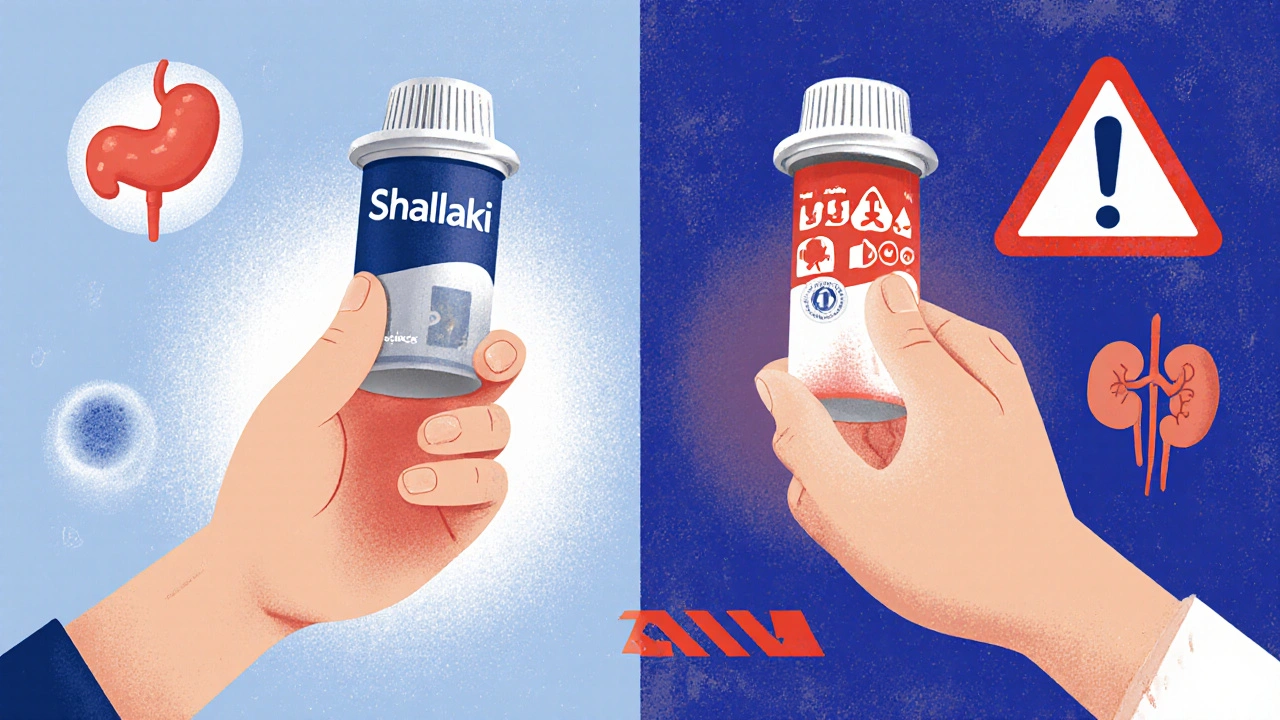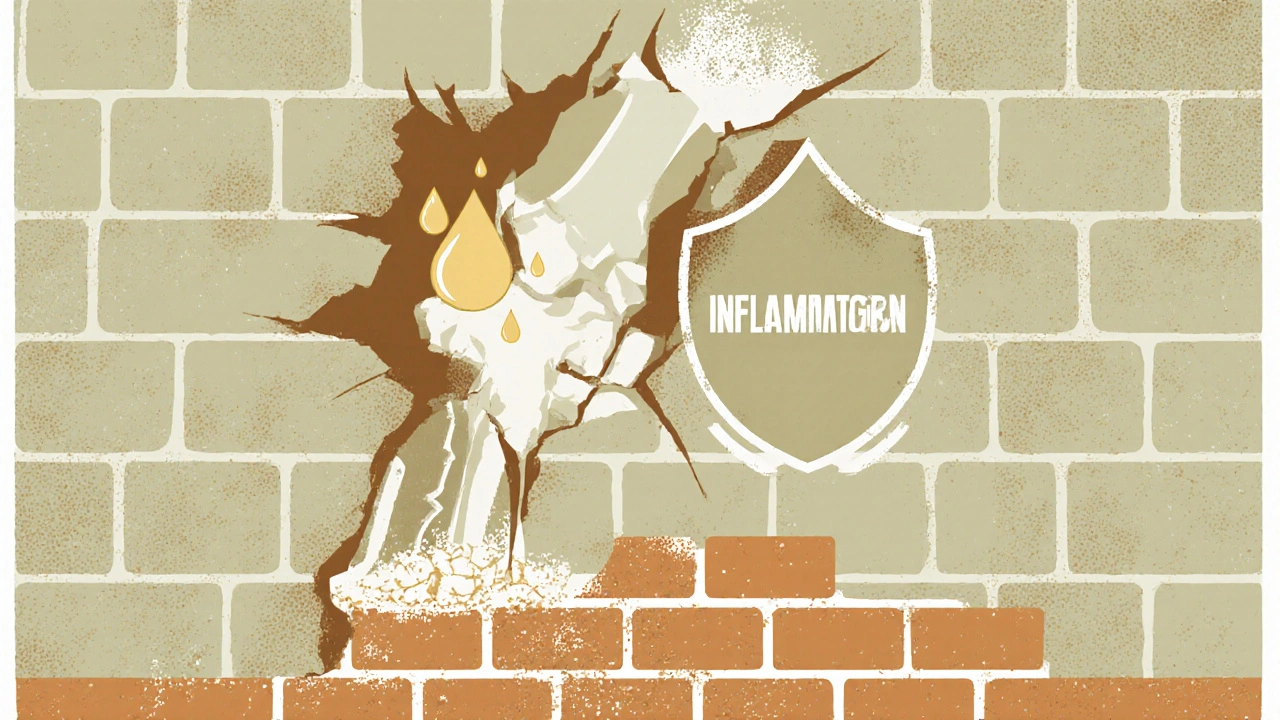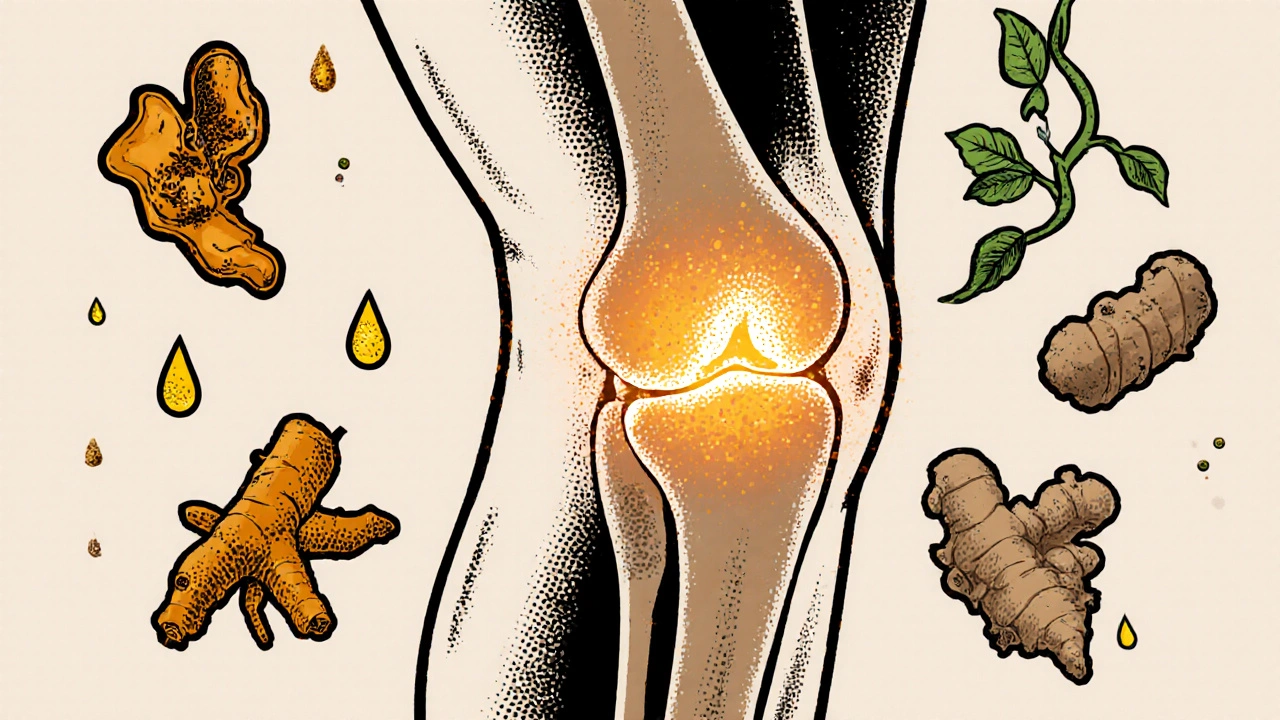Shallaki (Boswellic Acid) vs. Top Alternatives for Joint Pain and Inflammation
When you’ve been living with stiff knees, aching hips, or chronic joint pain, you start looking for anything that might help. Shallaki, also known as Boswellic Acid, has been turning heads in natural health circles for its ability to reduce inflammation without the gut irritation of NSAIDs. But is it really better than the other options out there? And if not, what else works just as well-or better?
What Exactly Is Shallaki (Boswellic Acid)?
Shallaki is the Ayurvedic name for the resin extracted from the bark of the Boswellia serrata tree, native to India and parts of North Africa. The active compounds in this resin are called boswellic acids-mainly AKBA (acetyl-11-keto-β-boswellic acid)-which block the enzyme 5-LOX that triggers inflammation in your body. Unlike ibuprofen or naproxen, which shut down all prostaglandins (including the good ones that protect your stomach lining), boswellic acids target only the inflammatory pathway.
Studies show that standardized Boswellia extracts (with at least 30% boswellic acids) can reduce knee pain by 30-50% in people with osteoarthritis within 4-8 weeks. One 2018 trial published in Phytomedicine found participants using Boswellia had improved walking distance and less morning stiffness compared to placebo. No liver or kidney damage reported. That’s rare for long-term anti-inflammatories.
How Does Shallaki Compare to Turmeric (Curcumin)?
Turmeric is the go-to natural anti-inflammatory for most people. Curcumin, its main active ingredient, is powerful-but poorly absorbed on its own. Most turmeric supplements need piperine (from black pepper) to even work. Even then, you need 500-1,000 mg of curcumin daily to see results.
Shallaki, on the other hand, works at lower doses. A typical effective dose is 250-500 mg of standardized extract (30% boswellic acids), taken once or twice a day. No extra absorption boost needed. In head-to-head studies, both reduce joint pain similarly, but Boswellia shows faster onset-some feel relief in under two weeks, while curcumin often takes 4-6 weeks.
Here’s the real difference: turmeric is great for general inflammation, but Boswellia is more targeted. If your pain is localized in joints, tendons, or cartilage, Shallaki wins. If you’re dealing with systemic inflammation-like from gut issues or skin conditions-curcumin might be the better fit.
Boswellia vs. Ginger Root Extract
Ginger is another kitchen staple with real science behind it. Studies show ginger extract can reduce knee osteoarthritis pain as effectively as ibuprofen, but with fewer side effects. It works by inhibiting COX-2 enzymes, similar to NSAIDs, but also has antioxidant effects.
But here’s the catch: ginger’s effect is more short-term. It helps with acute flare-ups-like after a long walk or workout-but doesn’t rebuild joint function over time. Boswellia, however, slows cartilage breakdown. One 2020 study in Journal of Medicinal Food found Boswellia reduced levels of MMP-3, a protein that eats away at cartilage. Ginger doesn’t do that.
So if you want quick relief after a bad day, ginger tea or capsules help. If you want to stop the damage and feel better over months, Boswellia is the longer-term play.
Devil’s Claw: A Strong Contender
Devil’s Claw (Harpagophytum procumbens) comes from southern Africa and has been used for centuries for joint pain. It contains harpagoside, which reduces inflammation and may even stimulate cartilage repair.
Research suggests Devil’s Claw is as effective as some prescription NSAIDs for lower back and knee pain. In a 2021 meta-analysis, patients using Devil’s Claw reported 35% less pain than placebo after 12 weeks. It’s especially popular in Europe for chronic back pain.
But it’s not for everyone. Devil’s Claw can interact with blood thinners and may lower blood sugar. It’s also not recommended if you have ulcers or gallstones. Boswellia doesn’t have these restrictions. If you’re looking for something gentle, safe, and well-tolerated over years, Shallaki edges out Devil’s Claw.

Willow Bark: The Original Aspirin
Willow bark contains salicin, which your body converts into salicylic acid-the same compound aspirin is made from. It’s been used since ancient times. Studies show it helps with mild to moderate joint pain, especially in the lower back.
But here’s the problem: salicin is slow-acting and inconsistent. The amount varies wildly depending on the tree, season, and extraction method. You might get 100 mg in one capsule and 300 mg in another. That makes dosing unreliable. Plus, if you’re sensitive to aspirin, you’ll likely react to willow bark too.
Boswellia doesn’t carry that risk. It’s not chemically related to aspirin. No stomach upset. No bleeding risk. And it works through a completely different biological pathway. For anyone wanting a natural alternative that doesn’t mimic pharmaceuticals, Shallaki is the smarter choice.
Collagen Supplements: Are They a Real Alternative?
Collagen peptides have exploded in popularity. Companies claim they rebuild cartilage, reduce joint pain, and improve mobility. And there’s some truth to it.
A 2023 review in Nutrients found that hydrolyzed collagen (especially type II) improved joint pain in 70% of participants over 6 months. It’s especially helpful for athletes or people with early cartilage wear.
But collagen doesn’t reduce inflammation. It’s more of a structural support. Think of it like adding mortar to a crumbling brick wall. Boswellia, on the other hand, stops the acid rain from eating the bricks in the first place.
Best approach? Use them together. Collagen gives your joints the raw materials to repair. Boswellia stops the inflammation that’s destroying them. That combo is powerful.
What About Prescription Anti-Inflammatories?
NSAIDs like diclofenac or celecoxib work fast. But they come with risks: stomach ulcers, kidney damage, increased heart attack risk with long-term use. The FDA warns against using them for more than 10 days without medical supervision.
Boswellia doesn’t have those risks. In fact, multiple studies show it’s safer for long-term use. One 2019 trial followed 120 people with osteoarthritis for a year. Those taking Boswellia had no liver or GI issues. The NSAID group? 22% reported stomach pain or bleeding.
If you’re on an NSAID and want to reduce dosage, switching to Boswellia can help. Many doctors now recommend it as a first-line natural option before jumping to drugs.

Who Should Take Shallaki? Who Should Avoid It?
Shallaki is ideal for:
- People with osteoarthritis in knees, hips, or hands
- Those with chronic low-grade joint inflammation
- Anyone wanting to avoid NSAIDs or steroids
- Athletes with overuse injuries
- People with sensitive stomachs who can’t tolerate ibuprofen
Avoid it if you:
- Are pregnant or breastfeeding (not enough safety data)
- Have a known allergy to Boswellia or frankincense
- Are on blood thinners-though risk is low, check with your doctor
Side effects are rare. Less than 2% report mild nausea or acid reflux. Take it with food to prevent that.
How to Choose the Right Shallaki Supplement
Not all Boswellia is created equal. Many products are diluted or use low-grade extracts. Here’s what to look for:
- Standardized extract: Must say "30% boswellic acids" on the label
- AKBA content: Look for at least 10% acetyl-11-keto-β-boswellic acid (the most potent form)
- Dose: 250-500 mg per capsule, taken once or twice daily
- Third-party tested: Check for USP, NSF, or ConsumerLab certification
Avoid products that just say "Boswellia serrata extract" without percentages. Those are often useless.
Bottom Line: Is Shallaki Worth It?
Yes-if your goal is to reduce joint inflammation without side effects, and you’re willing to wait a few weeks for results. It’s not a magic bullet, but it’s one of the few natural options with solid, repeatable science behind it.
Compared to turmeric: faster, more targeted, no absorption issues.
Compared to ginger: better for long-term joint protection.
Compared to Devil’s Claw: safer for daily use.
Compared to willow bark: consistent dosing, no aspirin risk.
Compared to collagen: tackles the root cause (inflammation), not just the symptom.
And compared to NSAIDs: no liver damage, no ulcers, no heart risks.
Shallaki isn’t the only tool in the shed-but for joint pain, it’s one of the most reliable ones you can trust.
How long does it take for Shallaki to work for joint pain?
Most people start noticing reduced stiffness and pain within 2-4 weeks. For full benefits-like improved mobility and slower cartilage breakdown-it typically takes 6-8 weeks of consistent use. Don’t expect overnight results, but the effects build steadily and last.
Can I take Shallaki with other supplements like glucosamine?
Yes, and many people do. Glucosamine helps rebuild cartilage, while Boswellia reduces the inflammation that breaks it down. Together, they work like a team: one repairs, the other protects. No known interactions exist, and clinical studies often combine them for better outcomes.
Is Boswellia the same as frankincense?
Yes and no. Frankincense is the aromatic resin from the Boswellia tree, traditionally burned as incense. Shallaki refers specifically to the medicinal extract of that resin, standardized for boswellic acid content. You can’t get therapeutic doses from burning frankincense-it’s for aroma, not anti-inflammation.
Does Shallaki help with rheumatoid arthritis?
Some studies show Boswellia can reduce joint swelling and morning stiffness in rheumatoid arthritis, but it’s not a replacement for disease-modifying drugs. It can be used as a complementary therapy to reduce flare-ups and lower NSAID use. Always work with your doctor if you have autoimmune arthritis.
Where can I buy reliable Shallaki supplements in the UK?
Look for brands like Swisse, Now Foods, or Gaia Herbs that clearly state "30% boswellic acids" and "10% AKBA" on the label. Many are available through Boots, Holland & Barrett, or trusted online retailers like Amazon UK (check seller ratings). Avoid generic or unbranded products-quality varies wildly.






14 Comments
Lenard Trevino
November 1 2025Okay so I tried Shallaki for like 3 months straight after my knee surgery and let me tell you-this stuff is not some hippie fairy dust. I was skeptical as hell, but after week 4 I started noticing I could walk to the mailbox without wincing. And no stomach burn like ibuprofen gave me. I mean, I used to take 2 Advil just to sit down and watch TV. Now I take one capsule, chill, and actually enjoy my life again. I don’t care what the studies say-I feel it. That’s the real metric, right?
Paul Maxben
November 2 2025lol so boswellia is the new miracle cure? next theyll tell us apple cider vinegar cures cancer. you know what else blocks 5-lox? steroids. and guess what? the pharma companies dont want you to know about this because they make billions off NSAIDs. its all a scam. they dont want you healed, they want you dependent. i saw a video on youtube where a guy in india was walking barefoot on hot coals after taking shallaki. thats real power right there.
Molly Britt
November 3 2025They’re hiding this because it’s cheaper than pills. You think Big Pharma wants you to heal? Please. Look at the FDA’s funding sources. This is why you get sick in the first place.
Nick Cd
November 3 2025Okay so I’ve been taking Boswellia for 8 months now and I swear to god my hips feel like they did in 2008 before I started sitting on my ass all day. But here’s the thing-I also started doing yoga and eating turmeric lattes and drinking celery juice and sleeping 9 hours and now I’m basically a monk. I don’t know which one did it. Maybe it’s the moon phase. Maybe it’s the crystals I put next to my bottle. But I’m not taking any chances. I’m doing it all. Also I think the government is putting fluoride in the water to make us forget how to heal naturally. Just saying.
Patricia Roberts
November 5 2025Oh wow, so the ancient Indians figured out how to beat Big Pharma with a tree resin and now we’re all supposed to be impressed? How cute. Next you’ll tell me they used leeches and astrology to treat arthritis. I’m just here for the drama.
Adrian Clark
November 5 2025Let me get this straight-you’re telling me a resin from a tree is better than a billion-dollar drug developed by scientists with PhDs and mass-produced in sterile labs? That’s like saying your grandma’s chicken soup is better than Pfizer’s mRNA vaccine. I mean… maybe it is? But I still need a PhD to understand why.
Rob Giuffria
November 7 2025Here’s the truth nobody wants to admit: inflammation isn’t the enemy. It’s your body screaming for help. You’re not fixing the problem by suppressing it with a plant extract. You’re just silencing the alarm. The real issue? Your diet. Your stress. Your sleep. Your trauma. Shallaki doesn’t heal you-it just lets you ignore the fact that you’re still living like a zombie on energy drinks and Netflix. Wake up.
Barnabas Lautenschlage
November 9 2025I appreciate the depth of this breakdown. The comparison between Boswellia and other supplements is actually very well-researched and balanced. I’ve been using a 30% standardized extract for about six months now, mostly for hand osteoarthritis, and while it’s not a cure, it’s definitely slowed the progression. I pair it with magnesium glycinate and daily stretching. The key is consistency-not expecting magic, but allowing time for biological processes to respond. Also, third-party testing is non-negotiable. I’ve seen too many brands that just dump powdered bark into capsules and call it a day.
Ryan Argante
November 10 2025While the anecdotal evidence for Boswellia is compelling, I must emphasize the importance of clinical validation. That said, your comparison against other modalities is methodical and reflects a thoughtful synthesis of peer-reviewed literature. For patients seeking non-pharmacological intervention, this represents a pragmatic, evidence-informed pathway. I would recommend combining it with physical therapy for optimal functional outcomes.
Jeanette Case
November 12 2025OMG I just started this yesterday and my knees already feel lighter?? I’m crying. I’ve been on celecoxib for 3 years and my stomach is a warzone. This is my new favorite thing. I took it with my collagen and now I feel like I’m 25 again. Also I bought the one with the blue bottle from Gaia. Don’t buy the cheap ones!! 💪🌿😭
Leonard Buttons
November 12 2025Shallaki works but only if you get the right extract. I bought some from a random amazon seller and it did nothing. Then I found one with 10% AKBA and 30% boswellic acids-boom. 3 weeks later I could climb stairs without thinking about it. Also, take it with food. Otherwise you’ll feel like you swallowed a lemon.
Alice Minium
November 14 2025Wait so if I take this with glucosamine and turmeric and ginger and collagen and omega-3s and vitamin D and magnesium and… is that too much? I’m scared I’m gonna overdose on plants. Also I read somewhere that boswellia can mess with your hormones? Is that true? I don’t wanna grow a beard.
Stephen Maweu
November 14 2025For anyone new to this stuff-don’t go crazy buying 5 different supplements. Start with Boswellia alone for 6 weeks. Track your pain on a scale of 1-10. If you don’t feel anything, try another. If you do? Awesome. Then add collagen if you want to go further. Don’t let the hype overwhelm you. Simple is better. And yeah, get the 30% standardized stuff. It’s worth the extra $5.
anil kharat
November 16 2025As an Indian, I grew up seeing my grandmother grind Boswellia resin with milk and apply it to her knees. Back then we didn’t need science to tell us it worked. Now the West wants to patent it and sell it for $40 a bottle. We gave you this medicine for free for thousands of years. Now you call it ‘alternative’. Funny how that works. But hey, if it helps you, good. Just don’t forget where it came from.